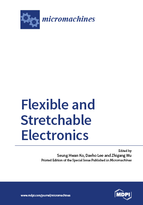Flexible and Stretchable Electronics
A special issue of Micromachines (ISSN 2072-666X).
Deadline for manuscript submissions: closed (31 December 2016) | Viewed by 118403
Special Issue Editors
Interests: sustainable energy devices; nanomaterial synthesis and characterization; microscale heat transfer; flexible and stretchable electronics
Special Issues, Collections and Topics in MDPI journals
Interests: Ni-based electronics; NiO nanoparticles; ZnO nanowires; ZnO nanoparticles; CuO nanoparticles; nanoparticle ink; transparent conductors; flexible sensors; laser processing
Special Issues, Collections and Topics in MDPI journals
Interests: soft robotics; bio-inspired soft microsystems; stretchable electronics; microfluidics; biomedical devices; non-conventional manufacturing technologies
Special Issues, Collections and Topics in MDPI journals
Special Issue Information
Dear Colleagues,
Flexible and stretchable electronics are getting tremendous attention as future electronics due to flexibility and light weight especially application in wearable electronics. Flexible electronics are usually fabricated on heat sensitive flexible substrates such as plastic, fabric or even papers while stretchable electronics are ussally fabricated elastomeric substrate to survive large deformation in the practical application scenarios. Therefore, the successful fabrication of flexible electronics needs a low temperature processible novel materials and novel processing development because traditional materials and processes are not compatible with flexible/stretchable electronics. Huge technical challenges and opportunities are behind this dramatically changes from the perspective of new material design and processing, new fabrication technique, large deformation mechanics, new application development and so on. Here, we would like to invite the talented researchers to join us on this new vital field that have a potential to reshape our future life, by contributing the wisdoms from your perspective.
Prof. Dr. Seung Hwan Ko
Prof. Dr. Daeho Lee
Prof. Dr. Zhigang Wu
Guest Editors
Manuscript Submission Information
Manuscripts should be submitted online at www.mdpi.com by registering and logging in to this website. Once you are registered, click here to go to the submission form. Manuscripts can be submitted until the deadline. All submissions that pass pre-check are peer-reviewed. Accepted papers will be published continuously in the journal (as soon as accepted) and will be listed together on the special issue website. Research articles, review articles as well as short communications are invited. For planned papers, a title and short abstract (about 100 words) can be sent to the Editorial Office for announcement on this website.
Submitted manuscripts should not have been published previously, nor be under consideration for publication elsewhere (except conference proceedings papers). All manuscripts are thoroughly refereed through a single-blind peer-review process. A guide for authors and other relevant information for submission of manuscripts is available on the Instructions for Authors page. Micromachines is an international peer-reviewed open access monthly journal published by MDPI.
Please visit the Instructions for Authors page before submitting a manuscript. The Article Processing Charge (APC) for publication in this open access journal is 2600 CHF (Swiss Francs). Submitted papers should be well formatted and use good English. Authors may use MDPI's English editing service prior to publication or during author revisions.
Keywords
- flexible electronics
- stretchable electronics
- wearable electronics
- printed electronics
- inkjet printing
- R2R printing
- low temperature process
- polymer substrate
- nanowires
- nanoparticles
- Skin Intelligence
- Soft Smartness
- Bio-inspired Microsystems
- Large Deformation Mechanics
- Soft Material and Processing
- Fabrication Technique for Soft Device









